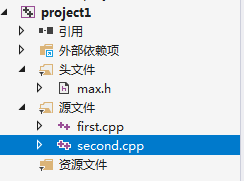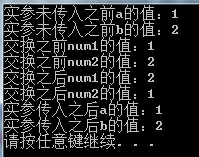作用:将一段常用的代码封装起来,减少重复代码;
函数定义5个步骤:返回值类型、函数名、参数列表、函数体语句、return表达式
int add(int num1,int num2){ int res = num1 + num2; return res; }
一、函数声明
通过函数声明,表明有这么一个函数存在:
#include<iostream> using namespace std;
//函数声明,可以只声明参数的类型
//由于进行了函数声明,虽然max函数在主函数之后,此时仍然是可以被调用的 int max(int, int); int main() { int a = 1; int b = 2; int res = max(a, b); cout << res << endl; system("pause"); return 0; }
//函数定义 int max(int a, int b) { int res = a > b ? a : b; return res; }
函数可以声明多次,但是只可以定义一次。
二、函数的分文件编写
函数分文件编写一般有以下四个步骤:
- 创建后缀名为.h的头文件
- 创建后缀名为.cpp的源文件
- 在头文件中写函数声明
- 在源文件中实现函数定义
作用:让代码结构更加清晰。
目录结构:

max.h
#include<iostream> using namespace std; int max(int, int);
second.cpp
#include "max.h" int main() { int a = 1; int b = 2; int res = max(a, b); cout << res << endl; system("pause"); return 0; } int max(int a, int b) { int res = a > b ? a : b; return res; }
三。值传递和引用传递
1.值传递
什么是值传递?
在函数调用时将实参的值传递给形参;
有什么特点?
值传递时,如果形参发生变化,则不会影响原来实参的值。
#include <iostream> using namespace std; void swap(int num1, int num2) { cout << "交换之前num1的值:" << num1 << endl; cout << "交换之前num2的值:" << num2 << endl; int tmp = num1; num1 = num2; num2 = tmp; cout << "交换之后num1的值:" << num1 << endl; cout << "交换之后num2的值:" << num2 << endl; } int main() { int a = 1; int b = 2; cout << "实参未传入之前a的值:" << a << endl; cout << "实参未传入之前b的值:" << b << endl; swap(a, b); cout << "实参传入之后a的值:" << a << endl; cout << "实参传入之后b的值:" << b << endl; system("pause"); return 0; }
输出:

2.引用传递
什么是引用传递?
在函数调用时将实参的引用(即指针)传递给形参;
引用传递的特点?
引用传递时,如果形参发生变化,则同时会影响原来实参的值。
#include <iostream> using namespace std; void swap(int* num1, int* num2) { cout << "交换之前num1的值:" << *num1 << endl; cout << "交换之前num2的值:" << *num2 << endl; int tmp = *num1; *num1 = *num2; *num2 = tmp; cout << "交换之后num1的值:" << *num1 << endl; cout << "交换之后num2的值:" << *num2 << endl; } int main() { int a = 1; int b = 2; int* p1 = &a; int* p2 = &b; cout << "实参未传入之前a的值:" << a << endl; cout << "实参未传入之前b的值:" << b << endl; swap(p1, p2); cout << "实参传入之后a的值:" << a << endl; cout << "实参传入之后b的值:" << b << endl; system("pause"); return 0; }
输出:
